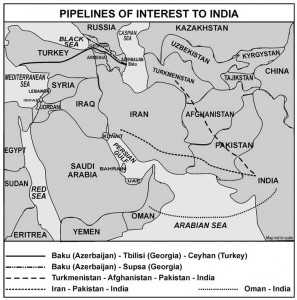India’s Energy Security Strategy
To meet the energy security challenges facing the country India has adopted a multi-pronged approach.
- Diversification of imported oil. India depends on Saudi Arabia, Nigeria, Iran and Kuwait for 60 percent of its oil imports. It is dependent on the Middle East for almost two-thirds of its oil imports for reasons of geography and cost.
- Purchase of Exploration Blocks. Indian oil companies have purchased exploration blocks in oilfields in a range of countries from Libya, Sudan, Iran to Myanmar and Russia.
- Strategic Reserve. The 2004 Government decision to establish petroleum reserve of 15 days consumption has been recommended to be increased to 90 days.
- Refining Capacity. The investments in oil refineries in Jamnagar have resulted in India emerging as the energy outsourcing hub. Jamnagar already boasts of the world’s third largest oil refinery and is set to emerge as the largest when Reliance Petroleum Ltd begins its operations.
- Natural Gas Pipelines under consideration. Consumption of natural gas is set to increase exponentially. India has the option to import gas through pipelines from neighbouring states or import liquefied natural gas through long term contracts. A pipeline traversing through several countries entails complex contractual framework and has an important bearing on geopolitics. India is keen to acquire gas from Iran, Bangladesh and Myanmar. The following pipeline proposals have been mooted :
- Oman–India deep water Pipeline (PPL).
- Iran–Pakistan–India (IPI) PPL.
- Turkmenistan–Afghanistan–Pakistan–India (TAPI) PPL.
- Qatar–Pakistan–India PPL.
- Myanmar–Bangladesh–India (MBI) PPL.
Politics in above Pipe Lines
Gas/Oil pipelines on the land route from the Persian Gulf region or Central Asian region need to traverse Pakistani territory before reaching India. It is believed that energy pipelines such as IPI and TAPI can effectively end the economic partition of the subcontinent, and give each country a stake in the other’s economy. A pipeline to India through Pakistan will lower the cost of gas for Pakistan, as well as provide it transit fee. However, the current tensions between US–Iran, and Pakistan–India, have complicated the IPI pipeline.
TAPI Pipeline which has the US backing is held up for improvement in the Afghan situation. Due to Dhaka’s unwillingness to provide passage for Myanmar’s gas to India, feasibility studies are on for a longer and more expensive pipeline that bypasses Bangladesh, altogether. However, with a new Government in place in Bangladesh, it is well nigh possible that the MBI pipeline may still fructify. The IPI may well turn into Iran–Pakistan–China pipeline due to ongoing tensions, and Chinese pressure and interest in making it a Iran–Pak–China pipeline. Also, Iran’s policy for seeking a uniform price for its gas imports represents a reversion from past policies.
This linkage is expected to increase the cost of Iranian gas by 80–90 percent offering India a consolidated price at Pak–India border. It is also insisting on negotiation of gas price one year prior to actual supply of gas. Keeping the above factors, and geopolitical tensions in mind India could also turn to :
- Baku–Ceyhan pipeline linking Azerbaijan and Turkey via Georgia.
- Baku–Supsa pipeline through Georgia and terminating at the Black Sea port of Supsa.
- Tengiz oil field to Novorossiysk port passing through Russia.
- Proposed Iran’s Caspian pipeline which envisages laying a pipeline along the Caspian sea bed.
- Kazakhstan–China oil pipeline could be extended to India.
- Siberia–China pipeline could be extended to India.
- Central Asia–Afghanistan (newly constructed Zarang–Delaram) route to Chabahar port of Iran–Persian Gulf.
It is important, here, to dwell on, at least, two of the above feasible pipelines, i.e. the Baku–Ceyhan and the Kazakh–China pipeline.





